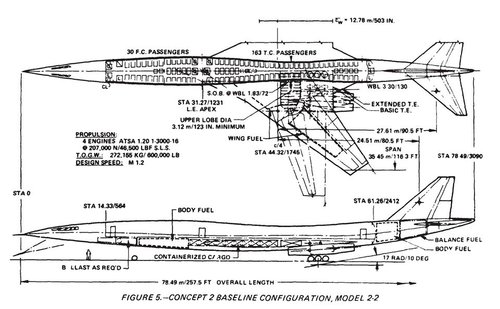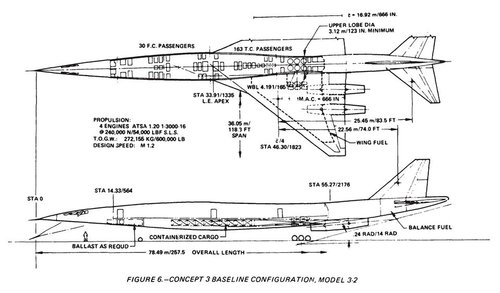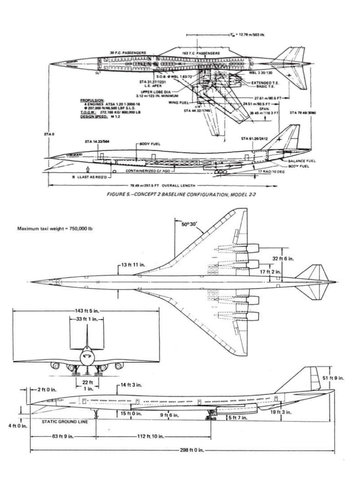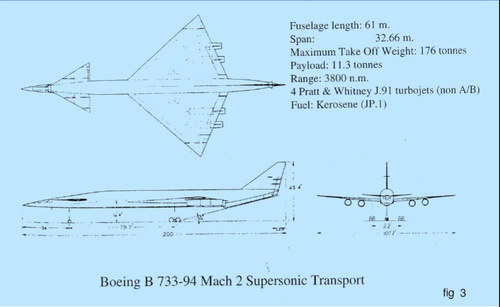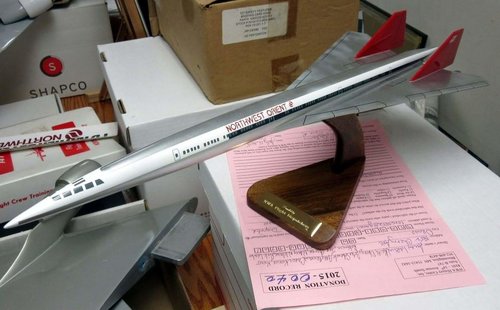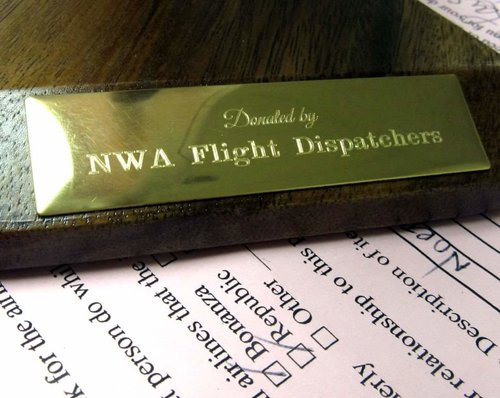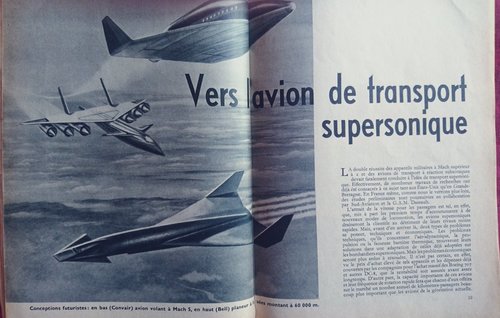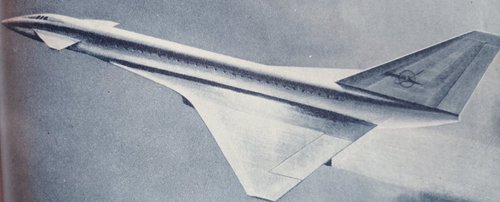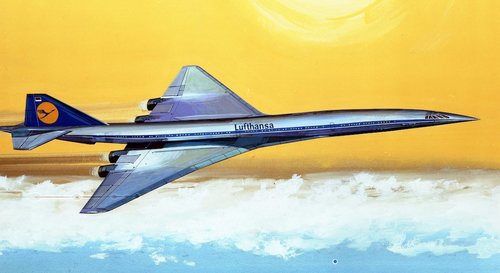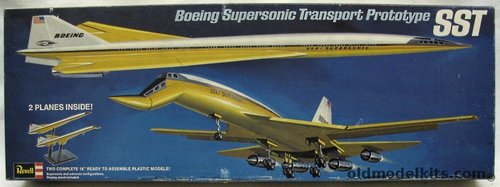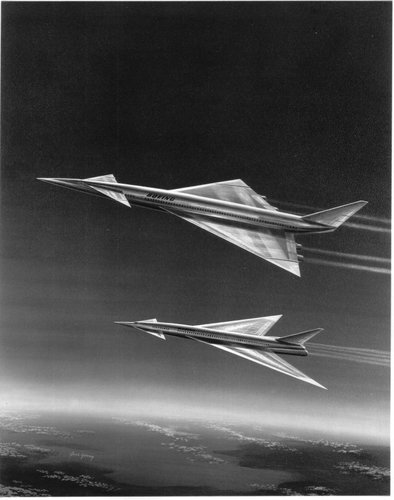You are using an out of date browser. It may not display this or other websites correctly.
You should upgrade or use an alternative browser.
You should upgrade or use an alternative browser.
US Supersonic Transport (SST) Program 1960-1971
- Thread starter Orionblamblam
- Start date
blackkite
Don't laugh, don't cry, don't even curse, but.....
- Joined
- 31 May 2007
- Messages
- 8,585
- Reaction score
- 6,786
Mmmm.............Post 2707-300? Fuselage shape looks like -300. Engine airintake without shock cone. Radically area ruled fuselage.
Design speed : Mach1.2!! Number of passengers : 193.
Design speed : Mach1.2!! Number of passengers : 193.
Last edited:
Yes indeed, thks Blackkite San. Seems to be a post SST stuf. But still looks like Boeing.
Can't find from where it's coming.
Can't find from where it's coming.
taildragger
You can count on me - I won a contest
- Joined
- 2 November 2008
- Messages
- 391
- Reaction score
- 476
My understanding is that area ruling is most valuable in the transonic range, so the reduced M1.2 design speed would explain the voluptuous fuselage. Perhaps an aerodynamacist could confirm.
Can someone identify these two and from which document they come from ? :
View attachment 630614
View attachment 630613
Found it on a Facebok page with no hint of from where it came (I hate facebok), Certainly looks very Boeing to me tho.
Ok found it... Our distinguished Hexham posted it already here in 2008 :
It's indeed from a 1973 Nasa paper.
Getting more and more difficult to find something that is not already posted here !
Peter "have you ever seen a grown man naked?" Graves is in this? The audience must have been in stitches when he appeared.
The movie dated from 1977 and"Airplane !" was done in 1980.
- Joined
- 9 October 2009
- Messages
- 21,144
- Reaction score
- 12,239
He was a brilliant actor.
- Joined
- 26 May 2006
- Messages
- 33,514
- Reaction score
- 13,597
The Boeing Model 733-94;
Attachments
- Joined
- 9 October 2009
- Messages
- 21,144
- Reaction score
- 12,239

NASA SCAT-16: Men and their toys (XXVIII).
Beginning in the early-1960s, NASA commenced the SCAT (Supersonic Commercial Air Transport) program. Twenty five different configurations were studied, eventually narrowed down to just a few which …
This model is at the Northwest Airline History center :
View attachment 632397
View attachment 632398
First time I see a twin tails Boeing SST, don't know if its a genuine Boeing stuff...
Maybe an old -100 scale model, restored with twin tails ?
I wonder what the idea behind such a version could be.
Nice find, either way!
martinbayer
ACCESS: Top Secret
- Joined
- 6 January 2009
- Messages
- 2,883
- Reaction score
- 2,972
Since it doesn't appear to have swing wings, it looks more like a fantasy hybrid of the 2707 and earlier B-70 derivative concepts.
Not sure about the wings... some 2707-100 models were made with wings swept back fixed, the whole thing molded in a single piece , with only a thin black line painted to separate the tailplane from what was supposed to be the swing wing.Since it doesn't appear to have swing wings, it looks more like a fantasy hybrid of the 2707 and earlier B-70 derivative concepts.
IMHO, this is one of these -100 models, been "restored" with twin tails, but without the black lines to represent the limit between wings and tailplanes. Maybe someone found a damaged old -100 model without fin, and repaired it like that.
Note, i've seen also pictures of -100s models been restaured with canards ala -200, cause it looks cool...
Doudtfull its a genuine Boeing stuff, or later modified , but posted it here anyway.
foiling
ACCESS: Secret
- Joined
- 12 August 2007
- Messages
- 365
- Reaction score
- 131
Magnificent artwork and very beautiful aircraft.I'm not sure if I posted in SPF before but here it is my L-2000 artwork.
blackkite
Don't laugh, don't cry, don't even curse, but.....
- Joined
- 31 May 2007
- Messages
- 8,585
- Reaction score
- 6,786
Hi! Convair Mach 5 design, etc.
https://twitter.com/yvemor?lang=he
https://twitter.com/yvemor?lang=he
Attachments
- Joined
- 3 June 2006
- Messages
- 2,955
- Reaction score
- 3,205
A 1966? Fairchild Republic SST concept art:


Some weird intakes ! Wonder how the spike shock cone would do with squared intake shape.A 1966? Fairchild Republic SST concept art:

blackkite
Don't laugh, don't cry, don't even curse, but.....
- Joined
- 31 May 2007
- Messages
- 8,585
- Reaction score
- 6,786
Indeed. I never seen such a air intake shape. Wing and fuselage shape looks like Skybolt-san's contribution.
Wing and fuselage shape looks like Skybolt-san's contribution.
https://www.secretprojects.co.uk/threads/republic-model-10-sst-from-1963.4717/
Is this three dimentional air intake? This drawing belongs here?
https://www.secretprojects.co.uk/threads/republic-model-10-sst-from-1963.4717/
Is this three dimentional air intake? This drawing belongs here?
Last edited:
HondaVT600
ACCESS: Restricted
- Joined
- 18 July 2020
- Messages
- 4
- Reaction score
- 3
The SST program has always fascinated me especially with the beauty of the designs and the fact that the Concorde which was already massive was dwarfed in terms of size to the designs that the US had proposed. One thing that always piqued my curiosity though...would it have been possible for the SST to actually take to the skies if the L-2000 was chosen instead of the 2707? Lockheed had a fair amount of experience with supersonic aircraft especially since they had the F-104 and the A-12 and SR-71 under their belt.

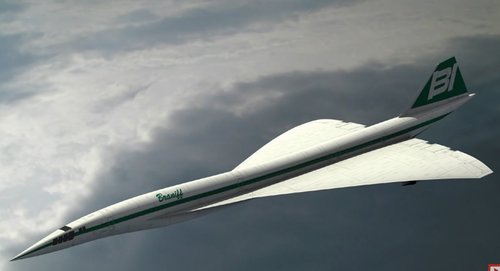
- Joined
- 27 December 2005
- Messages
- 16,906
- Reaction score
- 21,705
We have a good topic already on SSTs, but the gist of it was the L-2000 was probably buildable, but (like Concorde) could not be competitive with subsonic airliners. The premise of the 2707 was that using recent NASA research, you could have an SST that was able to somewhat compete with conventional airliners in terms of operating costs. It turned out that the fabled 2707 with VG wings was unbuildable with the technology of the time; the eventual fixed wing 2707 was no more competitive than L-2000 or Concorde.
HondaVT600
ACCESS: Restricted
- Joined
- 18 July 2020
- Messages
- 4
- Reaction score
- 3
We have a good topic already on SSTs, but the gist of it was the L-2000 was probably buildable, but (like Concorde) could not be competitive with subsonic airliners. The premise of the 2707 was that using recent NASA research, you could have an SST that was able to somewhat compete with conventional airliners in terms of operating costs. It turned out that the fabled 2707 with VG wings was unbuildable with the technology of the time; the eventual fixed wing 2707 was no more competitive than L-2000 or Concorde.
Thanks a lot for clearing this up. I always thought that the 2707 was canceled mainly due to environmental concerns, costs and delays. I did not know that the 2707-300 wouldn't have been anymore competitive than its counterpart from Lockheed or the Concorde. I'll be sure to look into the thread for further information
- Joined
- 27 December 2005
- Messages
- 16,906
- Reaction score
- 21,705
All of those were factors, but the overriding factor was you could build an SST from a technical perspective, but it could never get the same efficiency, so it was hard to see how you recouped the additional running costs. Some creative accounting assuming SSTs would make more flights per day (due to being faster) and therefore make similar money to a subsonic airliner despite higher costs was probably never going to be correct - it would have needed roughly similar pricing, no stress-based impacts on airframe life from supersonic flight, and no additional maintenance costs, none of which seems especially likely.
Part of the issue is that if you have a mixed fleet, and price SST seats as business class, say, all your business class passengers probably move over to SST flights, which makes your subsonic airliners less profitable. They rely on the first class/business class seats to make money.
The SST development never made much economic sense. Even today, it would be challenging. To me, the only obvious market is the business jet SST for billionaires - then cost becomes irrelevant.
Part of the issue is that if you have a mixed fleet, and price SST seats as business class, say, all your business class passengers probably move over to SST flights, which makes your subsonic airliners less profitable. They rely on the first class/business class seats to make money.
The SST development never made much economic sense. Even today, it would be challenging. To me, the only obvious market is the business jet SST for billionaires - then cost becomes irrelevant.
Viper2000
I really should change my personal text
- Joined
- 8 June 2018
- Messages
- 28
- Reaction score
- 50
Some creative accounting assuming SSTs would make more flights per day (due to being faster) and therefore make similar money to a subsonic airliner despite higher costs was probably never going to be correct - it would have needed roughly similar pricing, no stress-based impacts on airframe life from supersonic flight, and no additional maintenance costs, none of which seems especially likely.
I think that's rather an extreme position. An aircraft which is twice as productive can have half the life and still break even, because the airline is selling seat miles, not flying hours.
It can also burn more fuel, provided that this is offset by a corresponding cost reduction elsewhere (e.g. reduced crew costs due to higher productivity), or increased revenue (higher ticket prices).
You can't expect double the productivity from double the cruise MN, because of airspace, but there are big benefits to be had:
I found BA's timetable from 1978-9. I have calculated scheduled ground speeds based upon the great circle distance of 2,999 nmi.
If we look at LHR-JFK:
| Aircraft | Flight Number | Departure (UTC) | Arrival (UTC-5) | Arrival (UTC) | Gate to gate time | Great circle ground speed (knots) | Implied headwind |
| Concorde | BA173 | 0915 | 0800 | 1300 | 4:45 | 631 | 84.5 |
| 747 | BA175 | 1100 | 1335 | 1835 | 7:35 | 395 | 27.0 |
| Concorde | BA171 | 1115 | 1000 | 1500 | 4:45 | 631 | 84.5 |
| VC.10 | BA179 | 1800 | 2050 | 0150 | 7:50 | 382 | 28.5 |
JFK-LHR is on the opposite page:
| Aircraft | Flight Number | Departure (UTC-5) | Departure (UTC) | Arrival (UTC) | Gate to gate time | Great circle ground speed (knots) | Implied tailwind |
| VC.10 | BA178 | 0930 | 1430 | 2120 | 6:50 | 439 | 28.5 |
| Concorde | BA172 | 1000 | 1500 | 1845 | 3:45 | 800 | 84.5 |
| Concorde | BA170 | 1215 | 1715 | 2100 | 3:45 | 800 | 84.5 |
| 747 | BA176 | 2200 | 0300 | 0940 (next day) | 6:40 | 449 | 27.0 |
I have calculated the implied wind as being half the speed difference between the directions. It isn't obvious why Concorde's schedule appears to be based on double the assumed wind of the subsonic jets
In any case, Concorde is about 78% faster that the 747 flying West to East, and about 60% faster flying East to West.
Of course, in 1978, the expectation was that pax would check in an hour before departure (45 minutes at LHR for 1st class & Concorde), because the security theatre was less elaborate. Check-in delay reduces the door-to-door advantage somewhat, but 3 hours is still 3 hours, and this is an advantage for which people were, and are, prepared to pay a premium, especially for business travel (I suppose that some Americans might also be prepared to pay a premium for pleasure travel as well, given their limited holiday allowances).
The big productivity question is whether you can get an extra sector per day out of the crew. I don't know what Concorde's turnaround time was, so it's hard to comment with authority, but it looks pretty marginal. If we imagine BA173 turning around and becoming BA172 on the return journey, they would push back at 0915 and park up at 2100, which is already almost a 12 hour day, before we consider whatever briefing & pre-flight would be needed before the first flight of the day.
OTOH, flight time limitations were probably less restrictive in the 1970s.
My suspicion, however, is that a higher cruise MN would have been needed to make this work comfortably, which is perhaps why Concorde's original target was 2.2, and the Americans wanted 2.7.
The big problem with aircraft productivity is that you can only make an integer number of flights per duty period, and the real benefits only arise when you can get an extra sector in. I suppose this may have motivated the codeshare with Braniff to fly between New York & Washington DC.
- Joined
- 9 October 2009
- Messages
- 21,144
- Reaction score
- 12,239
I should note that the original plan for the Boeing 747 was that it would serve a relatively short time in the airliner role, being then progressively relegated to cargo planes & other secondary roles as SSTs became available.
royabulgaf
ACCESS: Top Secret
- Joined
- 29 December 2008
- Messages
- 671
- Reaction score
- 329
I'm so glad you calculated the flight times. Saving 2-3 hours is barely workable, given a dropoff to takeoff time of an hour or so. Also, it depends on the ticket premium, is the corporate travel department going to decide it's worth it? Nowadays, you're adding an hour or so of airport time at either end. Yes, you can probably get a flight or two extra per day in if you work the plane like a dog, however: there is a sweet spot where you want to land at your final point (business meeting at 9-10 AM, or hotel 4-6 PM). Also, do want to pay the big bucks to take a redeye? This sounds odd, but I think running the Concorde as a cargo aircraft where you can dump the seats, the cabin crew, etc. The Concorde was a fairly marginal aircraft. I vaguely recall it was designed for the New York-London trip, and needed reduced seats to make it on other runs. This would give the airlines and manufacturers and airlines time to figure out the SST in the real world,
I did some (very rough and approximate) calculations here.
By stretching boundaries a little, fact is a Mach 2.7 SST could make three Europe / New York rotations per day, when Mach 2.2 Concorde would make only two and 747 only one - and piston engine, 0.5.
With perfect hindsight the US choice of 250 passengers at Mach 2.7 was the correct one on economic grounds. They had done the maths pretty correctly.
On the Europe - N.Y - Europe airway, the most lucrative in the world even today...
Concorde carried 130 passengers two times per day - 260 passengers total.
SST would have carried 250 thrice in a day - 750 per day, thrice as much !
Note that a 747 would carry 400 passengers only once.
Maybe that's how they hoped to be competitive on transatlantic flights.
Transpacific by contrast with a 3500 miles range would have been rather hopeless...
Tokyo - Anchorage - Los Angeles
Tokyo - Hawaii - Los Angeles
What doomed the SST was
- time lost with Boeing stupid VG wing design
- range: the GE4 was grossly inefficient
- titanium construction - mandatory for Mach 2.7, but a giant PITA as recognized by Clarence Johnson about the A-12 family
- noise, obviously
- the oil shock and advent of ecology, too
By stretching boundaries a little, fact is a Mach 2.7 SST could make three Europe / New York rotations per day, when Mach 2.2 Concorde would make only two and 747 only one - and piston engine, 0.5.
With perfect hindsight the US choice of 250 passengers at Mach 2.7 was the correct one on economic grounds. They had done the maths pretty correctly.
On the Europe - N.Y - Europe airway, the most lucrative in the world even today...
Concorde carried 130 passengers two times per day - 260 passengers total.
SST would have carried 250 thrice in a day - 750 per day, thrice as much !
Note that a 747 would carry 400 passengers only once.
Maybe that's how they hoped to be competitive on transatlantic flights.
Transpacific by contrast with a 3500 miles range would have been rather hopeless...
Tokyo - Anchorage - Los Angeles
Tokyo - Hawaii - Los Angeles
What doomed the SST was
- time lost with Boeing stupid VG wing design
- range: the GE4 was grossly inefficient
- titanium construction - mandatory for Mach 2.7, but a giant PITA as recognized by Clarence Johnson about the A-12 family
- noise, obviously
- the oil shock and advent of ecology, too
Last edited:
- Joined
- 27 September 2006
- Messages
- 6,062
- Reaction score
- 6,164
The US SST belonged to an era when "faster" was seen as the natural next step. The impact of the 707 on air travel was expected to be repeated by the SST. Concorde like the Comet would be trumped by a larger, faster US design. As has been mentioned, 747s were designed so they could become cargo haulers like the DC7s had when jets replaced them.
Swing wings for the Boeing design (I love the madness of this and have numerous models and toys of it) was supposed to be easier to land and take off than a pure delta and be more economical. The original 733 version looked like a B1 bomber and was much closer to a Concorde in size. The eventual delta 300 version still tried, with its tailplane, to offer easier operation than a pure delta.
The supersonic boom problem, the disenchantment in the Nixon years with budget drainers as Vietnam dragged on, the mounting technical problems, killed the US SST in 1971. The fuel hike in 1973 would have if it had survived.
Like a lot of 60s dreams/madness the SST died in those grim years of the early 70s. Concorde would have joined it if France had not been so determined.
Swing wings for the Boeing design (I love the madness of this and have numerous models and toys of it) was supposed to be easier to land and take off than a pure delta and be more economical. The original 733 version looked like a B1 bomber and was much closer to a Concorde in size. The eventual delta 300 version still tried, with its tailplane, to offer easier operation than a pure delta.
The supersonic boom problem, the disenchantment in the Nixon years with budget drainers as Vietnam dragged on, the mounting technical problems, killed the US SST in 1971. The fuel hike in 1973 would have if it had survived.
Like a lot of 60s dreams/madness the SST died in those grim years of the early 70s. Concorde would have joined it if France had not been so determined.
- Joined
- 27 September 2006
- Messages
- 6,062
- Reaction score
- 6,164
Oooo, that Lufthansa drawing is gorgeous..Found courtesy of google images the Boeing 2707-300 in Pan Am and Lufthansa colours.
They appear to be original pictures sent to the airlines by Boeing.
Nice find!
- Joined
- 14 June 2006
- Messages
- 2,297
- Reaction score
- 480
BTW, at that Paris Air Show, NAA showed a 3-engine SST with a SCAT-something shape. I published it here a while ago ( i.e. 12 years, sigh). Maybe the Republic 3-engine design was SCAT-inspired too. Moreover, at same Paris, NAA CEO gave a full presentation to the press with gorgeous slides of the NAA SST work in progress (they ended to subcontracting from Boeing, if I remember well, like Republic, BTW). Maybe that presentation is now deep in Boeing archives.
blackkite
Don't laugh, don't cry, don't even curse, but.....
- Joined
- 31 May 2007
- Messages
- 8,585
- Reaction score
- 6,786
- Joined
- 27 September 2006
- Messages
- 6,062
- Reaction score
- 6,164
The US kit maker Revell issued a two plane Boeing SST set in the 60s based on this variant.
It was later reissued in Pan Am colours but this version was the original.
Attachments
Model 733-94What is the aircraft model located top of this large picture?
View: https://flic.kr/p/eePq1C
- Joined
- 27 September 2006
- Messages
- 6,062
- Reaction score
- 6,164
A publication well known to readers of this site has this original illustration.
The 733 later has a swing wing design which evolved into the Boeing 2707,-100 posted above
The 733 later has a swing wing design which evolved into the Boeing 2707,-100 posted above
Attachments
Similar threads
-
FLIGHTS OF FANTASY: The Lockheed L-2000 SST in airline service
- Started by Sentinel Chicken
- Replies: 9
-
Could the US have built an SST?
- Started by uk 75
- Replies: 35
-
-
Lockheed VLST Very Large Subsonic Transports aircraft
- Started by hesham
- Replies: 19
-

